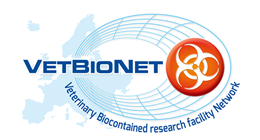Structure
 VetBioNet represents an infrastructure project and competence network that is dedicated to research on (re)emerging epizootic and zoonotic diseases. The project specifically targets high-impact infectious diseases of terrestrial and aquatic animals that are listed by the OIE (Office International des Epizooties – World Organisation for Animal Health) as notifiable diseases. The animal models required to study these OIE-listed infectious diseases include terrestrial livestock species, farmed fish and wildlife species. The VetBioNet consortium gathers the majority of Europe’s key research infrastructures permitting studies on host-pathogen interactions in these species in a high-containment (BSL3) environment and, hence, provides a unique service portfolio in the European research landscape. Through partnerships with pre-eminent non-European BSL3 infrastructures and/or research organisations, VetBioNet strives to further advance the competence and expertise of the network. The project will implement an outreach agenda in order to create links and, where applicable, twinning partnerships with international and European research programmes sharing interests in VetBioNet-related topics.
VetBioNet represents an infrastructure project and competence network that is dedicated to research on (re)emerging epizootic and zoonotic diseases. The project specifically targets high-impact infectious diseases of terrestrial and aquatic animals that are listed by the OIE (Office International des Epizooties – World Organisation for Animal Health) as notifiable diseases. The animal models required to study these OIE-listed infectious diseases include terrestrial livestock species, farmed fish and wildlife species. The VetBioNet consortium gathers the majority of Europe’s key research infrastructures permitting studies on host-pathogen interactions in these species in a high-containment (BSL3) environment and, hence, provides a unique service portfolio in the European research landscape. Through partnerships with pre-eminent non-European BSL3 infrastructures and/or research organisations, VetBioNet strives to further advance the competence and expertise of the network. The project will implement an outreach agenda in order to create links and, where applicable, twinning partnerships with international and European research programmes sharing interests in VetBioNet-related topics.
The project comprises 31 different work-packages (WPs) dedicated to six Networking Activities (WPs 1-6), three Joint Research Activities (WPs 7-9), Project Management (WP10), and 21 Transnational Access Activities (WP 11-31). The ensemble of all these integrating activities is centred on the VetBioNet BSL3 research infrastructures as the core topic of the project.
The proposed Networking Activities are specifically related to: Transnational Access Management (WP1); Development of a Preparedness Plan to enhance the preparedness of the VetBioNet BSL3 research infrastructures to respond to emerging infectious disease threats (WP2); Harmonisation of Best Practices and Biosafety/security standards (WP3); Ethical standards and social impact of VetBioNet research work (WP4); Dissemination, Data Management, and Training opportunities (WP5); and Development and implementation of a Sustainability Plan (WP6).
The Joint Research Activities are specifically designed to advance the scientific and technical state-of-the-art of research on epizootic and zoonotic diseases by: Establishing novel and/or optimised infection models (WP7); Developing and/or validating novel analytical tools (WP8); and Developing and/or validating novel telemetric or imaging tools (WP9).
The consortium proposes a total of 21 Transnational Access WPs to provide direct access to the partners’ proprietary BSL3 infrastructures (i.e. BSL3 animal experimental facilities and laboratories) and technological platforms as well as remote access to the partners’ sample collections, cell lines, immunological reagents, and animals. Transnational Access to the VetBioNet infrastructure resources will be granted to users proposing excellent, sound projects addressing various topics related to epizootic and zoonotic diseases. In addition, a number of partners propose remote access to on-demand samples (e.g. non-infected primary cells, nucleic acids, and decontaminated tissue slides) that can be analysed by the users in a non-contained laboratory environment.

